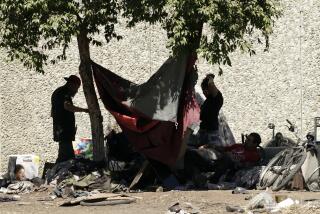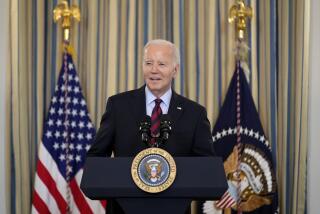1.8 Million Escape Poverty as ’84 Rate Drops Sharply
- Share via
WASHINGTON — After five years of steep increases, the nation’s poverty rate dropped sharply in 1984 as 1.8 million Americans left the ranks of the officially poor, the Census Bureau reported Tuesday.
Heating up a longstanding debate over whether government programs or private business help reduce poverty more, White House Communications Director Patrick J. Buchanan quickly termed the drop-off “an extraordinarily bountiful harvest of Reaganomics.”
Later, President Reagan, speaking from his Santa Barbara ranch, hailed the reduction as “further proof that the greatest enemy of poverty is the free enterprise system.”
However, three Democratic members of Congress, backed by a liberal group fighting Reagan-proposed budget cuts for the poor, called the decline disappointingly small and lamented new income figures that showed a widening gap between rich and poor.
The census report said that the number of persons below the official poverty line of $10,609 for a family of four fell 1.8 million to a total of 33.7 million last year. The overall poverty rate declined to 14.4% of the population from 15.3%, while poverty among the elderly reached the lowest level on record--12.4%.
The 1984 decline reversed a trend of growth from 1978 to 1983, during which the number of poor swelled by 11 million.
The Census Bureau, terming the drop-off “the most significant since 1976,” attributed it to improved economic conditions after two severe recessions.
However, Gordon W. Green, assistant chief of the Census Bureau’s population division, suggested that the poverty rate might undergo a less dramatic change this year because of the sluggish economy.
Buchanan invited a group of reporters from large publications to the White House to discuss “the unambiguous good news” of the poverty report.
“These numbers represent not only a triumph for Reagan economic policy (nicknamed Reaganomics) but also a triumph for the Reagan philosophy,” he said.
Brandishing a chart purporting to show that soaring welfare payments have not reduced poverty rates, Buchanan added: “This provides powerful evidence that American capitalism is the best machine ever devised to bring people out of poverty.”
Democrats Skeptical
Sen. Alan Cranston (D-Calif.) and Reps. Robert T. Matsui (D-Sacramento) and Charles B. Rangel (D-N.Y.), joined by the liberal Center on Budget and Policy Priorities, dismissed the reduction in poverty numbers.
“I don’t think the fact that poverty is down a little bit now is evidence that President Reagan’s economic policies are working, since the poverty rate is still significantly higher now than it was when he became our President,” Cranston said. The rate stood at 14% when Reagan took office.
Similarly, Robert Greenstein, director of the Washington-based budget center, said that the degree of reduction in the poverty rate was disappointing, given that the unemployment rate last year made “the largest single-year drop in recent decades,” falling from 9.6% to 7.5%.
Moreover, Rangel said, “the 0.9% reduction (in poverty) is not reflective of the widening gap between rich and poor and the increasing incidence of poverty among black and Hispanic children.”
Black Poverty Down
The census report, based on a nationwide survey of 60,000 households last March, showed the poverty rate for whites dropping from 12.2% to 11.5% last year, while the rate for blacks fell from 35.7% to 33.8%. There was no statistically significant change among Latinos.
The poverty rate among children under 18 declined from 22.2% to 21.3%. However, poverty among black children under age 6 increased again, reaching 51.5%--the highest level ever recorded.
The record-low 12.4% poverty rate for those 65 and older represented a 1.8-percentage-point decrease. At a briefing, Green attributed the big drop to increases in Social Security and Supplemental Security Income benefits.
In reporting the official poverty figures, the Census Bureau also released the latest in a series of controversial studies of how government programs affect poverty. The 1984 study estimated that there actually were 5 million to 11 million fewer persons in poverty if certain federal benefits such as Medicaid were counted as income.
Non-Cash Income
The official estimates of the number of people living in poverty are based only on their cash income. However, in the decades since the definition was first developed, the government has established many non-cash programs to assist the poor, such as food stamps, subsidized housing, low-cost school lunches and Medicaid (known in California as Medi-Cal). Because these programs improve life for the poor, Administration officials have suggested counting them as income, although there has been wide disagreement over how to place a value on the different programs.
The Census Bureau also disclosed Tuesday that while the poverty rate was dropping last year, real median family income was increasing significantly--but at a faster rate for the most affluent than for the least.
Overall, median family income grew by 7.7% before adjustment for the increase in consumer prices. The 3.3% real gain--to $26,430--followed a 1.6% real increase in 1983. Not since 1972 had family income risen at a faster rate, the report noted.
Income for the poorest two-fifths of all families was 15.7% of the national total--the lowest on record. Meanwhile, the wealthiest two-fifths received 67.3%, the highest ever recorded.
More to Read
Get the L.A. Times Politics newsletter
Deeply reported insights into legislation, politics and policy from Sacramento, Washington and beyond. In your inbox twice per week.
You may occasionally receive promotional content from the Los Angeles Times.










